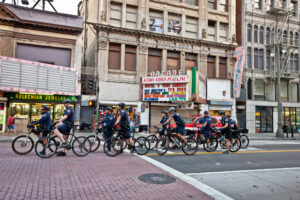
311 Service Requests
Learn More Metadata Download the Dataset View on Map Variable Definitions:Total 311 Call Rate: The number of 311 service requests made by community residents per
Variable Definitions:
Total 311 Call Rate: The number of 311 service requests made by community residents per 10,000 people in a given area. Residents can use 311 service requests for non-emergency municipal services.
Bulky Items Call Rate: The number of 311 service requests requesting a bulky item pickup per 10,000 people in a given area. The city offers free pick-up of large items such as mattresses, couches, doors, carpet, or toilets for residents who must dispose of such items.
Homeless Encampment Call Rate: The number of 311 service requests reporting homeless encampments per 10,000 people in a given area.
Illegal Dumping Call Rate: The number of 311 service requests reporting illegal dumping per 10,000 people in a given area. Illegal dumping is any disposal of solid waste outside of a legal disposal facility.
*Note: Service requests include requests submitted via dialing 311, call centers, email, mobile apps, website, and other sources.
Source:
Call Counts: City of Los Angeles Open Data Portal
Resident Population: American Community Survey, 5-year estimates
Years Available:
2016 – 2022
311 calls are non-emergency requests made to city or local governments, serving as a direct line for residents to report issues, request services, or obtain information on public services. Unlike 911 services for emergencies, 311 services cover everything from noise complaints to road repair, graffiti removal, and more (McEntire, 2023). This service, accessible via phone, web, and mobile app, embodies the city’s commitment to responsive and inclusive governance. The my311LA program represents a significant leap forward in making city services more accessible and user-friendly. The City launched the my311LA app in 2013 which has simplified reporting issues and requesting services, allowing residents to contribute to their community’s well-being with just a few taps on their smartphones (MyLA311 | City of Los Angeles, n.d.). This technological advancement improves efficiency and encourages a broader population to participate in civic life, particularly younger residents who may prefer digital communication channels.
The willingness to use 311 services varies among communities, often reflecting broader trust issues and satisfaction with government responsiveness (Hartmann, 2018). Some residents may be more inclined to report issues and request services, confident in the city’s capacity to address their concerns. Others may be hesitant due to past experiences of neglect or the perception that their voices will not lead to meaningful action (Hartmann et al., 2017). Understanding these dynamics is crucial for fostering a more inclusive and responsive civic ecosystem.
Homeless Encampment Calls: Perception and Reality
Calls concerning homeless encampments underscore the complex interplay between community perceptions, empathy, and frustration regarding homelessness (Agans et al., 2015). These reports can signal areas where homelessness is most visible but also raise questions about the societal approach to addressing homelessness (Funge et al., 2018). Are these calls driven by concerns for the welfare of homeless individuals, OR do they reflect desires to remove homelessness from sight? The city’s response to these calls can significantly influence public perceptions of homelessness and the effectiveness of interventions.
Written by Debarun Sarbabidya
Citations:
McEntire, K. (2023, May 4). What is 311 and When Should I Use it? SafeWise. https://www.safewise.com/blog/what-is-311/
Hartmann, S. (2018). Citizen Relationship Management for Civic Participation: How Smart Cities use 311 to Involve Citizens. Public Administration and Information Technology.
Hartmann, S., Mainka, A., & Stock, W.G. (2017). Citizen Relationship Management in Local Governments: The Potential of 311 for Public Service Delivery.
Agans, R.P., & Liu, G. (2015). Public Attitudes Toward the Homeless. Global Journal of Science Frontier Research, 15.
Funge, S.P., Gabbard, W.J., & Turner, M.M. (2018). Victimization of the Homeless: Public Perceptions, Public Policies, and Implications for Social Work Practice. Journal of Social Work in the Global Community.
MyLA311 | City of Los Angeles. (n.d.). https://lacity.gov/myla311

Learn More Metadata Download the Dataset View on Map Variable Definitions:Total 311 Call Rate: The number of 311 service requests made by community residents per

There are disparities present in how the justice system treats communities of color, including the Latino population. These disparities are greatest for Black populations, which

This story was created as a part of the NDSC Criminal Justice Data Initiative. In the spring of 2019, the USC Price Center partnered with
